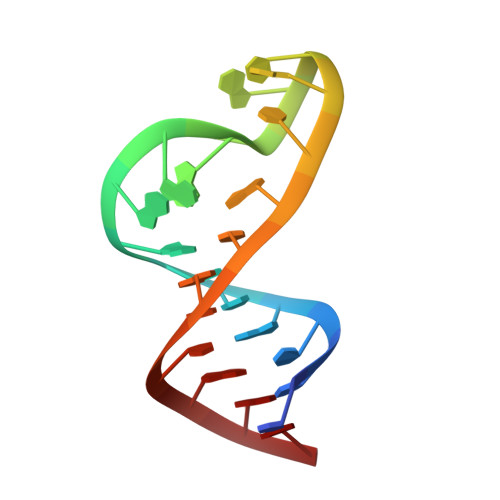HIV-1(Lai) genomic RNA: combined used of NMR and molecular dynamics simulation for studying the structure and internal dynamics of a mutated SL1 hairpin.
Kieken, F., Arnoult, E., Barbault, F., Paquet, F., Huynh-Dinh, T., Paoletti, J., Genest, D., Lancelot, G.(2002) Eur Biophys J 31: 521-531
- PubMed: 12451421
- DOI: https://doi.org/10.1007/s00249-002-0251-1
- Primary Citation of Related Structures:
1JTJ - PubMed Abstract:
The genome of all retroviruses consists of two identical copies of an RNA sequence associated in a non-covalent dimer. A region upstream from the splice donor (SL1) comprising a self-complementary sequence is responsible for the initiation of the dimerization. This region is able to dimerize in two conformations: a loop-loop complex or an extended duplex. Here, we solve by 2D NMR techniques the solution structure of a 23-nucleotide sequence corresponding to HIV-1 SL1(Lai) in which the mutation G12-->A12 is included to prevent dimerization. It is shown that this monomer adopts a stem-loop conformation with a seven base pairs stem and a nine nucleotide loop containing the G10 C11 A12 C13 G14 C15 sequence. The stem is well structured in an A-form duplex, while the loop is more flexible even though elements of structure are evident. We show that the structure adopted by the stem can be appreciably different from its relaxed structure when the adenines A8, A9 and A16 in the loop are mechanically constrained. This point could be important for the efficiency of the dimerization. This experimental study is complemented with a 10 ns molecular dynamics simulation in the presence of counterions and explicit water molecules. This simulation brings about information on the flexibility of the loop, such as a hinge motion between the stem and the loop and a labile lattice of hydrogen bonds in the loop. The bases of the nucleotides G10 to C15 were found outside of the loop during a part of the trajectory, which is certainly necessary to initiate the dimerization process of the genuine SL1(Lai) sequence.
Organizational Affiliation:
Centre de Biophysique Moléculaire, CNRS affiliated to Orléans University and to INSERM, rue Charles Sadron, 45071 Orléans Cedex 02, France.














